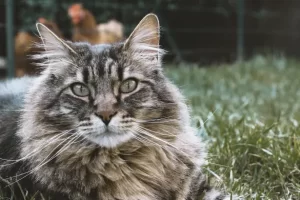Last updated on February 5th, 2023 at 07:39 pm

Cats can maintain themselves well. However, some of these more prevalent feline illnesses and health problems cannot be avoided by your careful feline. Most of the time, it will be a simple problem like a minor infection. However, cats occasionally develop serious illnesses, so it is a great idea to be prepared. Detecting cat problems earlier is crucial as you can prevent them through medication and other ways before they become very serious and cost you lots of money. In this article, let’s take a look at some common cat health problems and their symptoms.
1. Urinary problems
Urinary issues in cats, often referred to as FLUTD (feline lower urinary tract disease), can be caused by stress, inflammation, stone development, infections, and more. Cats with urinary issues frequently struggle to pee and urinate, mostly in small quantities, not in their litter box. Male felines with this problem finding it hard to pee and this can affect them significantly. Cats who are overweight, middle-aged, get a little exercise, live in stressful surroundings like apartments with other cats, or constantly shifting routines may be more susceptible. Symptoms can manifest as painful urination, too much licking, urinating struggles, and more. Treatment is based on the cause, for instance, using antibiotics in case of an infection or surgery in case of stones.
RELATED: Cat Urinary Tract Infection Home Remedies
2. Diabetes
A complex condition known as diabetes affects cats and is either brought on by a deficiency in the hormone insulin or an insufficient reaction to insulin. Upon ingesting food, a cat’s digestive process separates it into several components, including glucose, which insulin then transports to its cells. Blood sugar levels rise in cats who either cannot release insulin or cannot use it normally. As a result, a cat develops hyperglycemia, which, if untreated, can lead to various challenging health issues. There are two types of diabetes, type I, which involves the ability of the cat not to make insulin, and type II, a reduced ability to produce insulin and an insufficient ability to react to the hormone. Diabetes symptoms include losing weight, appetite change, dehydration, urinating frequently, and more.
RELATED: Cat Diabetes Signs, Causes & Treatments
3. Cancer
Cancer is another one of common cat health problems. Cats can develop various forms of cancer, just like people. Cells that grow out of control, infiltrate nearby tissue, and potentially spread to other body regions are the key aspects of the cancer disease class. It can be a tumor-like localized disease or a generalized disease that spreads throughout the entire body. Older cats and those with white heads and ears are more at risk of cancer. The cancer types include squamous cell carcinoma, caused by sun exposure regularly, and lymphosarcoma (symptoms rarely show for this type), which is more common in cats, especially the younger ones. Cancer involves symptoms like swelling, bad breath, lumps, losing weight, skin patches, breathing issues, and more. For this common cat health problem, treatment depends on what stage of cancer the cat is in, and it involves chemotherapy, surgery, immunotherapy, radiation, or multiple therapies.
4. Rabies
All mammals, including dogs, cats, and people, are susceptible to the highly contagious illness rabies, which attacks the spinal cord and brain. The fact that rabies is nearly always fatal when symptoms appear is a good reason why most people fear this condition. It can be caused by an animal bite, saliva from an animal with rabies, and more. A cat with rabies may have symptoms like paralysis, appetite loss, seizures, disorientation, more vocalization, behavior change, weakness, and in extreme cases, sudden death. Cats must be vaccinated as this keeps them safe and also the people it bites. If your cat shows signs of rabies, you should use gloves to keep yourself safe and book an appointment with your vet. If your cat has bitten you, it is best to see a doctor immediately.
5. Diarrhea
Cats may experience diarrhea due to various conditions, such as liver disease, allergies, cancer, spoiled food, intestinal parasites, etc. Loose, liquid, or watery stools are signs of diarrhea. Diarrhea can persist for a single day, a week, or even months, depending entirely on its underlying cause. Provide your cat with plenty of fresh water if it has diarrhea to keep the feline from becoming dehydrated. Then stop feeding the cat for up to 12 hours. If your cat still has diarrhea the following day, visit the veterinarian right away. See the vet immediately if you observe vomiting, bloody or dark stools, lethargy, fever or decreased appetite, or struggles to urinate.
RELATED: Home Treatment For Cat With Diarrhea
6. Obesity
For cats, obesity is one of common cat health problems that can result in several other health problems, including cardiovascular disease and diabetes. Because overweight cats are unable to engage in the activities that cats typically enjoy, such as pouncing on toys and jumping on trees, this lessens their life quality. You should give your cat the right amount of nutritious food and plenty of playtimes to keep him from becoming overly chubby. Cats can get a lot of exercise from cat trees and other toys for them to be in good shape.
7. Tick and flea
Tick and flea is in our next common cat health problems list. Cats frequently get fleas, which can be physically uncomfortable, and they may also be at risk for disease transmission. Ticks are possibly more harmful because they are more likely to spread diseases when they feed. A feline with ticks and fleas can have symptoms like dandruff, flakes, scabs on the skin, hair loss, and increased licking and scratching. It is important to constantly check for ticks and fleas for your cat’s safety. Treatment involves using oral tablets, powders, and sprays depending on the damage caused. You can consult your vet to know what tick and flea control will work for you. For instance, you can utilize flea and tick collars, which have significantly improved and can help with control and repellency; however, they need to be changed every thirty days.
RELATED: Natural ways to get rid of fleas on cats
8. Skin infection
Cats can develop a variety of skin infections, including military dermatitis or yeast infections which can be due to allergens like fleas. Felines who have diabetes or other medical conditions may be more susceptible to develop a skin infection. Cats with skin infections frequently overgroom to reduce the itch and irritation. You should consult your vet to find out what might be wrong with your cat if you start to recognize excessive grooming, rashes, matted fur, lumps, or bald spots. A cat’s breed, gender, and lifestyle can influence its risk of developing different skin problems; mostly, outdoor cats are more susceptible. Depending on the condition’s underlying cause, the symptoms may differ. Getting in touch with your vet as soon as you notice an issue would be best because various skin conditions can exhibit similar signs. They can offer assistance with precise diagnosis and treatment recommendations.
9. Eye problems
Numerous conditions, including corneal ulcers, conjunctivitis, cataracts, trauma, glaucoma, viruses, retinal diseases, and inflammatory conditions, can lead to eye issues in cats. Some indications that your cat may have eye issues include tear-stained fur, watery eyes, cloudiness, white or red eyelid linings, eye corners with gunk, squinting, eye pawing, or a 3rd eyelid that is easily visible. There’s not much you can do besides calling your vet if you don’t know the cause of the eye problems. Eye issues should be treated as an emergency, so schedule an appointment right away.
RELATED: 9 Common Eye Problems In Cats
10. Worms
Numerous intestinal parasites, including some commonly known as worms, can be acquired by cats. Numerous symptoms can result from intestinal worm infestations. Although the infestation may be a potentially serious health issue, cats occasionally show little to no visible signs of infection. Certain parasitic worms from felines can also cause human health risks. Some major worm types that affect cats include hookworms, roundworms, lungworms, and tapeworms. Although the method of transmission can differ, one of the primary ways cats contract worms is by ingesting the infected cats’ feces; additionally, cats can give their kittens worms. Cats with worms may have symptoms like bloody stool, constipation, coughing, anemia, diarrhea, bloating, and more. Some de-wormers do not eliminate all worm species. Therefore, you should avoid treating them at home. Your cat’s form of worm infestation will be identified by your vet, who will also recommend the most effective treatment option.
11. Dental issues
Dental disease is next in our list of common cat health problems, and the most typical dental issues include gingivitis (gum inflammation), periodontitis (significant tooth and gum damage), and tooth resorption (erosion of tooth dentin). Dental problems may manifest as irritated gums, bad breath, teeth discoloring, drooling, missing/loose teeth, and eating difficulties. Your cat needs a thorough dental cleaning to treat gingivitis. Your veterinarian will analyze your cat’s teeth to see if it has periodontitis to determine the severity of the condition and whether teeth need to be extracted; The teeth that are resorbing will also need to be extracted. Regular dental cleanings and daily brushing are the perfect ways to keep your cat’s mouth healthy and free of dental illnesses.
12. Vomiting
Cats frequently experience vomiting, which can have a variety of causes, including ingesting something hazardous or indigestible, infections, diabetes, urinary problems, or hairballs. Indications of vomiting can be abdominal heaving and drooling. Vomiting can cause your cat to become dehydrated very fast, so if your cat keeps vomiting or starts acting sick, call your veterinarian instantly. It might be beneficial to bring a sample of the cat’s vomit to the veterinarian.
RELATED: My Cat Vomits After Eating! What To Do?
13. Feline Immunodeficiency Virus
The feline immunodeficiency virus, which attacks the immune system and makes cats more prone to various other diseases and infections, is identical to HIV. Although FIV cannot be cured, it can be managed. FIV-positive cats will need ongoing care to ward off infection forever. The symptoms of this virus are swelling lymph nodes, fever, sneezing, hair loss and a bad coat, dental issues, and nose and eye discharge.
14. Upper respiratory infections (URI)
It is a bacterial, fungal, or viral infection that affects a feline’s throat, mouth, and nose. The calicivirus and feline herpesvirus are cats’ main causes of upper urinary infections. Mycoplasma, Bordetella, and Chlamydophila are other illnesses that a cat might contract, which would result in a cold. Kittens’ immature immune systems put them at higher risk of contracting this infection. Symptoms of URI can include appetite loss, fever, sneezing, lethargy, coughing, nose and eye discharge, mouth ulcers, and congestion. Like a typical human cold, the symptoms are mild but still bothersome. However, they can occasionally get worse. Take your cat to the veterinarian if you realize it is not eating, has a fever, or is struggling to breathe. Your veterinarian will probably advise using nose, and eye drops to relieve the symptoms in cats with minor urinary respiratory infections. Your cat may require antivirals, antibiotics, and hospitalization for more serious conditions.
15. Broken bones
Broken bones and fractures can occur easily and can be challenging to spot in cats, especially those who live outdoors. It happens more when cats lose focus, get startled, fall from trees or rooftops, and even get startled by a car. Indoor cats are also prone to falls from windows or high places around the house. They cannot communicate their pains to you, which can be hard to tell. Howling and moaning more frequently, louder, or longer than normal, appetite loss, and swelling in the injured region are warning signs to watch out for. When lightly touched, your cat may be in pain if they moan. Take your cat to the veterinarian immediately for a checkup if you think they might have broken bones since they will be suffering a great deal if not treated.
Conclusion
Cats are vulnerable to varying health issues; some are mild, while others can cause severe problems. Each problem has its specific symptoms, and some are common in most health conditions. Treatment also differs based on the issue your cat is having. Keeping an eye on your cat’s health is crucial because it can be incredibly distressing when it becomes ill. Schedule his vet visits accordingly and be vigilant for any symptoms of illness. I hope this article will help you be more ready to handle different common cat health problems and easily identify them.
Additional Resources:
10 Plants That Are Dangerous To Cats


